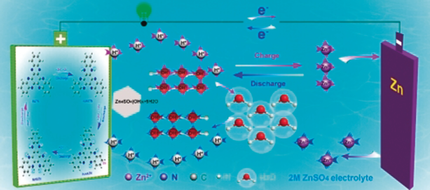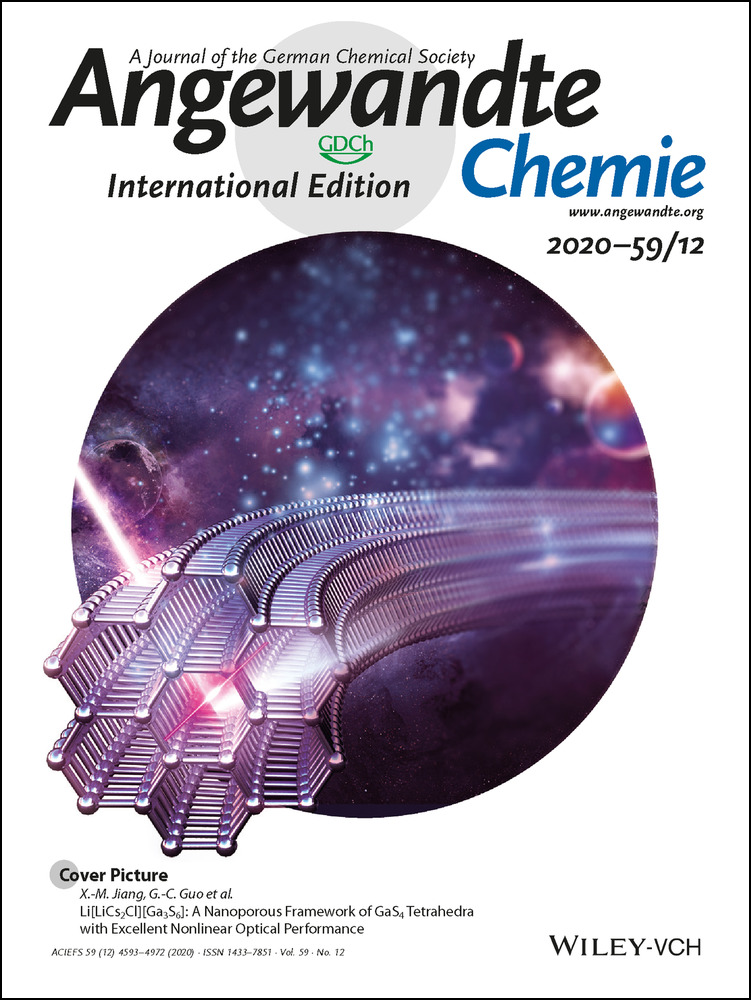Proton Insertion Chemistry of a Zinc–Organic Battery
Zhiwei Tie
Key Laboratory of Advanced Energy Materials Chemistry (Ministry of Education), Renewable Energy Conversion and Storage Center, College of Chemistry, Nankai University, Tianjin, 300071 P. R. China
Search for more papers by this authorLuojia Liu
Key Laboratory of Advanced Energy Materials Chemistry (Ministry of Education), Renewable Energy Conversion and Storage Center, College of Chemistry, Nankai University, Tianjin, 300071 P. R. China
Search for more papers by this authorShenzhen Deng
Key Laboratory of Advanced Energy Materials Chemistry (Ministry of Education), Renewable Energy Conversion and Storage Center, College of Chemistry, Nankai University, Tianjin, 300071 P. R. China
Search for more papers by this authorProf. Dongbing Zhao
State Key Laboratory and Institute of Elemento-Organic Chemistry, College of Chemistry, Nankai University, Tianjin, 300071 P. R. China
Search for more papers by this authorCorresponding Author
Prof. Zhiqiang Niu
Key Laboratory of Advanced Energy Materials Chemistry (Ministry of Education), Renewable Energy Conversion and Storage Center, College of Chemistry, Nankai University, Tianjin, 300071 P. R. China
Search for more papers by this authorZhiwei Tie
Key Laboratory of Advanced Energy Materials Chemistry (Ministry of Education), Renewable Energy Conversion and Storage Center, College of Chemistry, Nankai University, Tianjin, 300071 P. R. China
Search for more papers by this authorLuojia Liu
Key Laboratory of Advanced Energy Materials Chemistry (Ministry of Education), Renewable Energy Conversion and Storage Center, College of Chemistry, Nankai University, Tianjin, 300071 P. R. China
Search for more papers by this authorShenzhen Deng
Key Laboratory of Advanced Energy Materials Chemistry (Ministry of Education), Renewable Energy Conversion and Storage Center, College of Chemistry, Nankai University, Tianjin, 300071 P. R. China
Search for more papers by this authorProf. Dongbing Zhao
State Key Laboratory and Institute of Elemento-Organic Chemistry, College of Chemistry, Nankai University, Tianjin, 300071 P. R. China
Search for more papers by this authorCorresponding Author
Prof. Zhiqiang Niu
Key Laboratory of Advanced Energy Materials Chemistry (Ministry of Education), Renewable Energy Conversion and Storage Center, College of Chemistry, Nankai University, Tianjin, 300071 P. R. China
Search for more papers by this authorDedicated to 100th anniversary of Nankai University
Graphical Abstract
Abstract
Proton storage in rechargeable aqueous zinc-ion batteries (ZIBs) is attracting extensive attention owing to the fast kinetics of H+ insertion/extraction. However, it has not been achieved in organic materials-based ZIBs with a mild electrolyte. Now, aqueous ZIBs based on diquinoxalino [2,3-a:2′,3′-c] phenazine (HATN) in a mild electrolyte are developed. Electrochemical and structural analysis confirm for the first time that such Zn–HATN batteries experience a H+ uptake/removal behavior with highly reversible structural evolution of HATN. The H+ uptake/removal endows the Zn–HATN batteries with enhanced electrochemical performance. Proton insertion chemistry will broaden the horizons of aqueous Zn–organic batteries and open up new opportunities to construct high-performance ZIBs.
Supporting Information
As a service to our authors and readers, this journal provides supporting information supplied by the authors. Such materials are peer reviewed and may be re-organized for online delivery, but are not copy-edited or typeset. Technical support issues arising from supporting information (other than missing files) should be addressed to the authors.
| Filename | Description |
|---|---|
| anie201916529-sup-0001-misc_information.pdf2.4 MB | Supplementary |
Please note: The publisher is not responsible for the content or functionality of any supporting information supplied by the authors. Any queries (other than missing content) should be directed to the corresponding author for the article.
References
- 1
- 1aJ. Zheng, Q. Zhao, T. Tang, J. Yin, C. D. Quilty, G. D. Renderos, X. Liu, Y. Deng, L. Wang, D. C. Bock, C. Jaye, D. Zhang, E. S. Takeuchi, K. J. Takeuchi, A. C. Marschilok, L. A. Archer, Science 2019, 366, 645–648;
- 1bH. Qiu, X. Du, J. Zhao, Y. Wang, J. Ju, Z. Chen, Z. Hu, D. Yan, X. Zhou, G. Cui, Nat. Commun. 2019, 10, 5374;
- 1cM. Song, H. Tan, D. Chao, H. J. Fan, Adv. Funct. Mater. 2018, 28, 1802564;
- 1dH. Zhang, Q. Liu, Y. Fang, C. Teng, X. Liu, P. Fang, Y. Tong, X. Lu, Adv. Mater. 2019, 31, 1904948.
- 2
- 2aJ. Ding, Z. Du, L. Gu, B. Li, L. Wang, S. Wang, Y. Gong, S. Yang, Adv. Mater. 2018, 30, 1800762;
- 2bF. Wan, L. Zhang, X. Dai, X. Wang, Z. Niu, J. Chen, Nat. Commun. 2018, 9, 1656;
- 2cC. Xia, J. Guo, P. Li, X. Zhang, H. N. Alshareef, Angew. Chem. Int. Ed. 2018, 57, 3943–3948; Angew. Chem. 2018, 130, 4007–4012;
- 2dM. H. Alfaruqi, V. Mathew, J. Song, S. Kim, S. Islam, D. T. Pham, J. Jo, S. Kim, J. P. Baboo, Z. Xiu, K.-S. Lee, Y.-K. Sun, J. Kim, Chem. Mater. 2017, 29, 1684–1694;
- 2eF. Wan, Z. Niu, Angew. Chem. Int. Ed. 2019, 58, 16358–16367; Angew. Chem. 2019, 131, 16508–16517.
- 3
- 3aT. Wei, Q. Li, G. Yang, C. Wang, Adv. Energy Mater. 2019, 9, 1901480;
- 3bJ. Ding, Z. Du, B. Li, L. Wang, S. Wang, Y. Gong, S. Yang, Adv. Mater. 2019, 31, 1904369;
- 3cF. Wan, Y. Zhang, L. Zhang, D. Liu, C. Wang, L. Song, Z. Niu, J. Chen, Angew. Chem. Int. Ed. 2019, 58, 7062–7067; Angew. Chem. 2019, 131, 7136–7141.
- 4
- 4aD. Chao, W. Zhou, C. Ye, Q. Zhang, Y. Chen, L. Gu, K. Davey, S.-Z. Qiao, Angew. Chem. Int. Ed. 2019, 58, 7823–7828; Angew. Chem. 2019, 131, 7905–7910;
- 4bM. Li, Q. He, Z. Li, Q. Li, Y. Zhang, J. Meng, X. Liu, S. Li, B. Wu, L. Chen, Z. Liu, W. Luo, C. Han, L. Mai, Adv. Energy Mater. 2019, 9, 1901469;
- 4cC. Xu, B. Li, H. Du, F. Kang, Angew. Chem. Int. Ed. 2012, 51, 933–935; Angew. Chem. 2012, 124, 957–959.
- 5
- 5aQ. Yang, F. Mo, Z. Liu, L. Ma, X. Li, D. Fang, S. Chen, S. Zhang, C. Zhi, Adv. Mater. 2019, 31, 1901521;
- 5bL. Zhang, L. Chen, X. Zhou, Z. Liu, Adv. Energy Mater. 2015, 5, 1400930.
- 6
- 6aZ. Guo, Y. Ma, X. Dong, J. Huang, Y. Wang, Y. Xia, Angew. Chem. Int. Ed. 2018, 57, 11737–11741; Angew. Chem. 2018, 130, 11911–11915;
- 6bQ. Zhao, W. Huang, Z. Luo, L. Liu, Y. Lu, Y. Li, L. Li, J. Hu, H. Ma, J. Chen, Sci. Adv. 2018, 4, eaao 1761;
- 6cD. Kundu, P. Oberholzer, C. Glaros, A. Bouzid, E. Tervoort, A. Pasquarello, M. Niederberger, Chem. Mater. 2018, 30, 3874–3881;
- 6dH. Y. Shi, Y. J. Ye, K. Liu, Y. Song, X. Sun, Angew. Chem. Int. Ed. 2018, 57, 16359–16363; Angew. Chem. 2018, 130, 16597–16601.
- 7
- 7aH. Glatz, E. Lizundia, F. Pacifico, D. Kundu, ACS Appl. Energy Mater. 2019, 2, 1288–1294;
- 7bF. Wan, L. Zhang, X. Wang, S. Bi, Z. Niu, J. Chen, Adv. Funct. Mater. 2018, 28, 1804975;
- 7cA. Khayum M, M. Ghosh, V. Vijayakumar, A. Halder, M. Nurhuda, S. Kumar, M. Addicoat, S. Kurungot, R. Banerjee, Chem. Sci. 2019, 10, 8889–8894;
- 7dS. Huang, F. Wan, S. Bi, J. Zhu, Z. Niu, J. Chen, Angew. Chem. Int. Ed. 2019, 58, 4313–4317; Angew. Chem. 2019, 131, 4357–4361.
- 8Y. Lu, Q. Zhang, L. Li, Z. Niu, J. Chen, Chem Chem. 2018, 4, 2786–2813.
- 9X. Wu, J. J. Hong, W. Shin, L. Ma, T. Liu, X. Bi, Y. Yuan, Y. Qi, T. W. Surta, W. Huang, J. Neuefeind, T. Wu, P. A. Greaney, J. Lu, X. Ji, Nat. Energy 2019, 4, 123–130.
- 10
- 10aH. Pan, Y. Shao, P. Yan, Y. Cheng, K. S. Han, Z. Nie, C. Wang, J. Yang, X. Li, P. Bhattacharya, K. T. Mueller, J. Liu, Nat. Energy 2016, 1, 16039;
- 10bW. Sun, F. Wang, S. Hou, C. Yang, X. Fan, Z. Ma, T. Gao, F. Han, R. Hu, M. Zhu, C. Wang, J. Am. Chem. Soc. 2017, 139, 9775–9778;
- 10cJ. Huang, Z. Wang, M. Hou, X. Dong, Y. Liu, Y. Wang, Y. Xia, Nat. Commun. 2018, 9, 2906;
- 10dY. Jin, L. Zou, L. Liu, M. H. Engelhard, R. L. Patel, Z. Nie, K. S. Han, Y. Shao, C. Wang, J. Zhu, H. Pan, J. Liu, Adv. Mater. 2019, 31, 1900567.
- 11X. Wang, C. Bommier, Z. Jian, Z. Li, R. S. Chandrabose, I. A. Rodriguez-Perez, P. A. Greaney, X. Ji, Angew. Chem. Int. Ed. 2017, 56, 2909–2913; Angew. Chem. 2017, 129, 2955–2959.
- 12
- 12aV. Raab, E. Gauchenova, A. Merkoulov, K. Harms, J. Sundermeyer, B. Kovačević, Z. B. Maksić, J. Am. Chem. Soc. 2005, 127, 15738–15743;
- 12bM. A. Zirnstein, H. A. Staab, Angew. Chem. Int. Ed. Engl. 1987, 26, 460–461; Angew. Chem. 1987, 99, 460–461.
- 13C. Peng, G.-H. Ning, J. Su, G. Zhong, W. Tang, B. Tian, C. Su, D. Yu, L. Zu, J. Yang, M.-F. Ng, Y.-S. Hu, Y. Yang, M. Armand, K. P. Loh, Nat. Energy 2017, 2, 17074.
- 14M. H. Alfaruqi, V. Mathew, J. Gim, S. Kim, J. Song, J. P. Baboo, S. H. Choi, J. Kim, Chem. Mater. 2015, 27, 3609–3620.
- 15
- 15aB. Tian, Z. Ding, G.-H. Ning, W. Tang, C. Peng, B. Liu, J. Su, C. Su, K. P. Loh, Chem. Commun. 2017, 53, 2914–2917;
- 15bM. Takahashi, Y. Ishikawa, J.-i. Nishizawa, H. Ito, Chem. Phys. Lett. 2005, 401, 475–482.
- 16V. Krishnakumar, N. Prabavathi, Spectrochim. Acta Part A 2010, 77, 238–247.
- 17J. Hong, M. Lee, B. Lee, D. H. Seo, C. B. Park, K. Kang, Nat. Commun. 2014, 5, 5335.
- 18L. Liu, L. Miao, L. Li, F. Li, Y. Lu, Z. Shang, J. Chen, J. Phys. Chem. Lett. 2018, 9, 3573–3579.
- 19J. Lee, H. Kim, M. J. Park, Chem. Mater. 2016, 28, 2408–2416.





